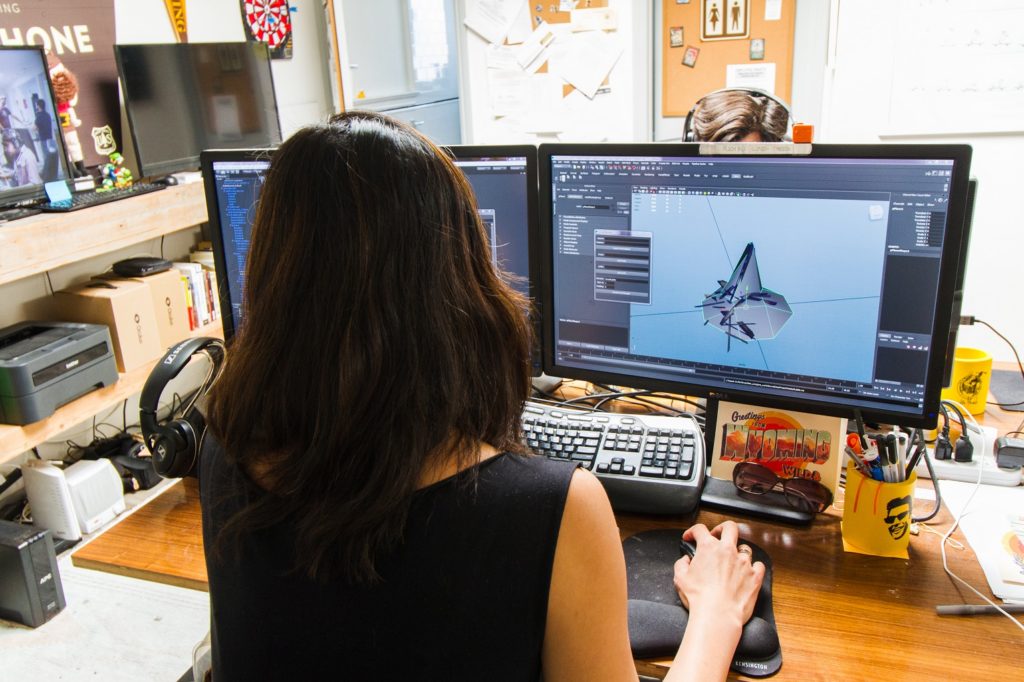This article is part of Issue 8.5, a digital zine available to Kill Screen’s print subscribers. Read more about it here and get a copy yourself by subscribing to our soon-to-be-relaunched print magazine.
///
When an architect drafts a design, they dream big. And where there’s an architect, there’s a craftsman—the person who sits down to bring the concept to life. At San Francisco-based independent game studio Campo Santo, that craftsman is 13-year industry veteran Jane Ng. But instead of fully-realizing buildings, she realizes game art, most recently that of the impeccably stylized Firewatch. “I’m like the builder that comes in and says, ‘I can actually build your building,’” Ng told me over mint-infused coffee in the warehouse-filled SOMA district in San Francisco. “And I really enjoy figuring out how to make that kind of thing.”
Humor and spirit whisk our conversation through Ng’s deep history (she even jokes at one point that she’s probably the “oldest” person working at Campo Santo, citing the high burnout rate in the industry). She dresses professionally—certainly not abiding to the lazy hoodie-clad tech culture of San Francisco startups—but not in a stuffy manner. Ng exudes an air of a deserved calm that comes from the finality of releasing Firewatch after nearly three years in development.
While she is an artist, Ng doesn’t discern herself as one in the traditional sense. Instead of collecting paintings and a litany of favorite artists, she chases life experiences, or more specifically, non-videogame related hobbies. Her job is to bring other artists’ art to life, like a true craftsman. “I think it’s something that people don’t really recognize in a lot of production art stuff is that I [may] call myself an artist, but really I don’t feel as much of an ‘artist’ as people say what the word artist means,” she explained.

Ng says her initial leap into videogames was “kind of like an accidental thing.” She grew up in Hong Kong before moving to the United States and studying engineering. As a self-described “inbetween person” interested in both art and engineering, Ng decided to explore the field of visual effects. “I always played games as a kid,” said Ng. “But it was just not one of those things you never thought about as a career.” In her visual effects studies, Ng landed an internship at her mentor’s “garage”-like game company, Ronin Entertainment. After graduating, Ng stayed at Ronin, until it eventually “went away” and she moved to EA.
At EA, Ng worked as an environment artist on Return of the King (2003) and a senior artist on Spore (2007). “I think when you stay at a big company, they do have a lot more specializations,” said Ng of her experiences at the large company. “The system makes you go, ‘Oh you’re very good at this,’ so there’s always a need for people who are very specialized, and you end up feeling very specialized. [It’s] very narrowing.” In late 2007, Ng left EA to join Double Fine Productions. During her six year stint at Double Fine, Ng worked on numerous games, from environment art on the delightful Russian-doll-inspired Stacking (2011) to lead artist on Ron Gilbert’s The Cave (2013). Ng recalls her time at Double Fine fondly, even when she was hit with the most categorically mundane of tasks, like optimizing The Cave for mobile. “For a lot of people, that would be like the most boring thing,” said Ng. “But I actually really enjoyed it on a technical level.”
Ng’s moved from big, to medium, to small studios throughout her career. “I’m glad I’ve sort of had the whole range,” she said. “For me at least, I have the luxury of not so much choosing the company, but more I know that this company or this group is doing this project that I’m very interested in. And it just so happens to be smaller.” After her time at Double Fine, Ng changed studios again, this time to the 10-person Campo Santo, where she worked as the solo 3D environment artist on Firewatch. “Being in a small company is almost harder, because more of it is on you,” she said. “I think the thing is that after 13 or 15 years, depending on when you start counting, after that long, I finally feel like I’m only now, or two years ago, even capable of thinking that I can do something like Firewatch.”

On Campo Santo’s Firewatch, Ng worked as an artist alongside prolific graphic designer Olly Moss, his first venture into game development, a stark contrast to Ng’s decade-plus of experience in games. “I think people who have done videogames a lot tend to be very aware. Like I’m very aware of production challenges, and my natural tendency is to [avoid] that kind of thing,” explained Ng. “Olly has that sort of outsider, fresh look on things since [game development is] very recent with him. There [are] some people who when you work with them in visual development, they want a hundred percent of what they propose to be in the game. But Olly’s not like that, he proposes a sensibility, we try to push as close to it as possible.” The end result is the distinct painterly look of Firewatch, and its perfectly hued, wondrous recreations of the Wyoming wilderness. “It’s nice that [our] inspiration comes up from [a] non-videogame-y canon thing.”
During a panel at the Game Developer’s Conference this past March, Ng led a discussion entitled “Making the Art of Firewatch,” about building the hyper-stylized forests of the game within development tool Unity. Ng’s technical acumen was on display in a talk full of “scenefiles” and other Unity jargon. I found myself enamored by Ng’s process, and the behind-the-scenes aspects of environmental design. Like how foliage only flows when the wind blows its way; the way the game’s lush trees act as barriers until the eventual fire in the woods slowly eats away at them as the game progresses, thus unlocking new areas. As Ng noted in the panel, a game world itself must facilitate story progression, and Firewatch’s does.
Despite having “artist” in her job description, Ng shies away from identifying herself as such—at least in the classic ‘artist that loves art’ sense. “I’m really terrible with names, like I don’t know who designed what, or who’s my favorite painter or whatever,” said Ng. “I actually am very much not that kind of person, which I think may be surprising for some people. For me personally, I really like working with people with a very strong sense of personal direction and I just like to implement the thing that they do.” Like a craftsman to an architect, Ng realizes the art of others. She’s the realistic, practical side of the dreamer.

However, Ng’s technical art isn’t entirely reliant on her colleagues’ artistic visions. Her inspirations, instead of coming from other art, blossom from the most grounded of experiences: having an interesting life. “I like cooking. I like travelling, I wanna make sure I do other things [besides videogames],” explained Ng. “It’s hard to quantify, like how does hiking really inform your art, but really, well obviously, you never know if you have to make a forest. That kind of stuff, just gathering a lot of interesting experiences I think is more personally important to me, [rather] than going out to museums.”
In spite of her busy career, Ng recalls no low points in terms of projects she’s worked on. “I’ve never had to go, ‘Oh this is just a job job,’ so I have to like, suffer through or anything,” said Ng. “Maybe that’s just a survival mechanism. But I’ve really enjoyed most, if not all, the projects I’ve had to do.” In the coming year, Ng anticipates a well-deserved ‘break’ of sorts—“my next project,” she said of her upcoming parental leave, “is to ship this baby.”
To read more of Issue 8.5, be sure to sign up to become a subscriber to our redesigned print magazine.
